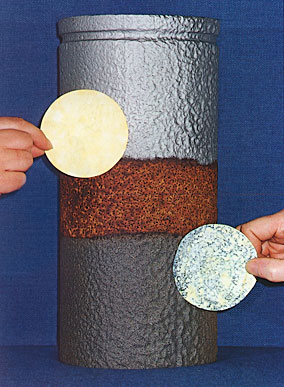
Request a No-Obligation Quote For Steel Surface Preparation, Linings and Coatings
Request Pricing InformationCase Study: Soluble Corrosion Salts
The Hidden Reason For Poor Coating Performance
“System 918” is an in inhibited variable low pressure wet abrasive blasting technique, invented developed and available only through KUE Engineering’s Contract Division. “System 918” has the unique ability to be infinitely varied by controlling not only air pressure but also water and abrasive volumes. By this fine control it is possible to achieve optimum results in such diverse fields as the selective removal of individual coats of paint or the blasting back to a true Sa 3 white metal free of soluble salts. This finish can be maintained for up to 24 hours by the use of the inhibitor system, thus allowing high production rates prior to coating. “System 918′ has been proven to be the only effective on-site method of removing soluble corrosion salts from steel substrates, thus ensuring that the threat of substrate corrosion beneath an ostensibly sound paint film does not occur.
These factors, combined with the system’s intrinsic safety, allow for its use in gassed up areas such as gas plants and refineries. This, together with the lack of operator fatigue and the low site down time factor, enables “System 918 ” to be selected for surface preparation , confident in the knowledge that the proven ex tended coaling longevity will be attained by the ultimate in steel surface preparation.

KUE “System 918”
Soluble ferrous salts in a steel surface are the main cause of paint failures. Countless millions are wasted on the application of expensive coatings to what appears, to the naked eye, to be a clean surface. The adjacent photographs show a test using potassium ferricyanide papers. A section of badly corroded steel tube was used as a sample, the lower section having been blasted by a normal dry grit method and the upper section having been blasted using “System 918“.
De-ionised water was then sprayed on to the two section s and the potassium ferri-cyanide test papers applied. The photographs show the highly damaging telltale blue markings of soluble salts (the origin of paint blistering) still present in the section which was subjected to normal dry blasting, whilst the section cleaned by “System 918” shows no signs of soluble salts.
In short, “System 918” leaves a clean surface able to safely accept coatings for long term corrosion protection. Access hatch doors showing clear evidence of the effects of salt water corrosion. Corrosion pits up to 20 mm deep and tho presence of corrosion salts in the porous cast iron wore common.


Images Above
Access hatch doors showing clear evidence of the effects of salt water corrosion. Corrosion pits up to 20 mm deep and the presence of corrosion salts in the porous cast iron wore common.



Images Above
Further inspections are carried out to ensure the integrity of the new lining using a high voltage spark tester which will detect flaws such as pinholes, holidays or low film build. After satisfactory completion of the film thickness and coating integrity inspections, the final coat, a hard, glossy vinyl ester finish containing wax is applied. The items are now ready for transportation back to Bradwell for reinstallation by the main contractor.
KUE Group Limited, Birksland Street, Bradford BD3 9SU United Kingdom Tel: +44 (0)1274 721188www.kuegroup.com
